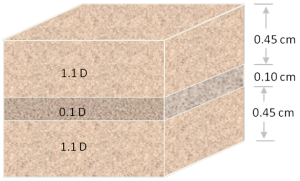What is a darcy?
/Permeability is the capacity of a porous material to transmit fluids. The SI unit of permeability is m2 (area) but the units adopted by the petroleum industry have been named after Henry Darcy, who derived Darcy's law. The darcy is a confusing jumble of units which combines standardized SI units from laboratory tests. By definition, a material of 1 darcy permits a flow of 1 cm3/s of a fluid with viscosity 1 cP (1 mPa.s) under a pressure gradient of 1 atm/cm across an area of 1 cm2.
Apart from having obscure units with an empirical origin, permeability can be an incredibly variable quantity. It can be as low as 10-9 D for tight gas reservoirs and shale, to 101 D for unconsolidated reservoirs. Just as electrical resistivity, values are plotted on a logarithmic scale. Many factors such as rock type, pore size, shape and connectedness and can affect fluid transport over volume scales from millimetres to kilometres. For a nice commentary on permeability in connection to continental scale near-surface hydrolithologic categories, read Anne Jefferson's (@highlyanne's) new post on Highly Allochthonuous.
 Okay then, with that said, what is the upscaled permeability of the cube of rock shown here? In other words, if you only had to find one number to describe the permeability of this sample, what would it be? I'll pause for a moment while you grab your calculator... Okay, got an answer? What is it?
Okay then, with that said, what is the upscaled permeability of the cube of rock shown here? In other words, if you only had to find one number to describe the permeability of this sample, what would it be? I'll pause for a moment while you grab your calculator... Okay, got an answer? What is it?
If you are like most people, you would define the upscaled permeability by computing the arithmetic average by adding the three contributing zones, weighted by their proportion:
Even if you didn't do this calculation rigorously, most people would look at the three values shown (1.1 D, 0.1 D, and 1.1 D) with respect to their relative proportions, and say that the upscaled permeability must be somewhere between the lowest value and the highest value. You might even speculate, since there is 9 times more of the high perm rock than the low perm rock, that the average is just a little less than 1.1 D.
If you got 1.0 D for your answer, you are only half right. Sorry if you feel like I set you up, but this isn't the final answer.
Here's why it's only half of the solution: 1.0 D is the horizontal permeability of the sample. In fact, upscaling permeability is meaningless unless a direction is coupled with it. For this example, 1 cm3 of water (at 1 cP) would take one second to travel through this rock under horizontal pressure gradient of one atmosphere. That same 1 cm3 of water would take 85% longer to travel through our sample under a vertical pressure gradient of the same magnitude. And obviously if there is no pressure gradient, there is no flow.
To correctly calculate the vertical permeability, the harmonic, not arithmetic, mean should be used:
Upscaling is routinely done in geoscience and reservoir characterization, because we have to compare measurements at different scales. It is important for geoscientists and engineers to be aware of the pitfalls of averaging and upscaling, and understand when to choose the correct formula. Because even the right answer could be the wrong answer with upscaling. If you were surprised by this little tutorial, go test a friend or colleauge. Even simple concepts are worth refreshing from time to time. See if you can get them thinking about the differences between horizontal and vertical permeability, and the impacts of arithmetic and harmonic averaging (upscaling) on the work that you do. Please leave a message in the comments if you are able to stump or surprise your peers.
 I have been pointed to a couple of wonderful resources for students of reservoir engineering, hydrogeology, and anyone else interested in fluid flow through porous media.
I have been pointed to a couple of wonderful resources for students of reservoir engineering, hydrogeology, and anyone else interested in fluid flow through porous media.
First is a very easy-to-read yet studious paper about Henry Darcy and his work on the municipal water systems of Dijon, France: Freeze, RA (1994), Henry Dijon and the fountains of Dijon, Ground Water 32 (1), doi:10.1111/j.1745-6584.1994.tb00606.x. At the time of writing, the PDF is available online here.
Second is the complete translation of Darcy's book, Les fontaines publiques de la ville de Dijon (1856). You can buy the book for $99 from the translator's website (also note the many links on that page). The original work (in mid-19th Century French, so good luck!) is available online here at the Bibliothèque nationale de France.
For any die-hard Darcy fans out there, I also stumbled on this atlas of the fountains, which purports to be an authentic first-edition.








 Except where noted, this content is licensed
Except where noted, this content is licensed